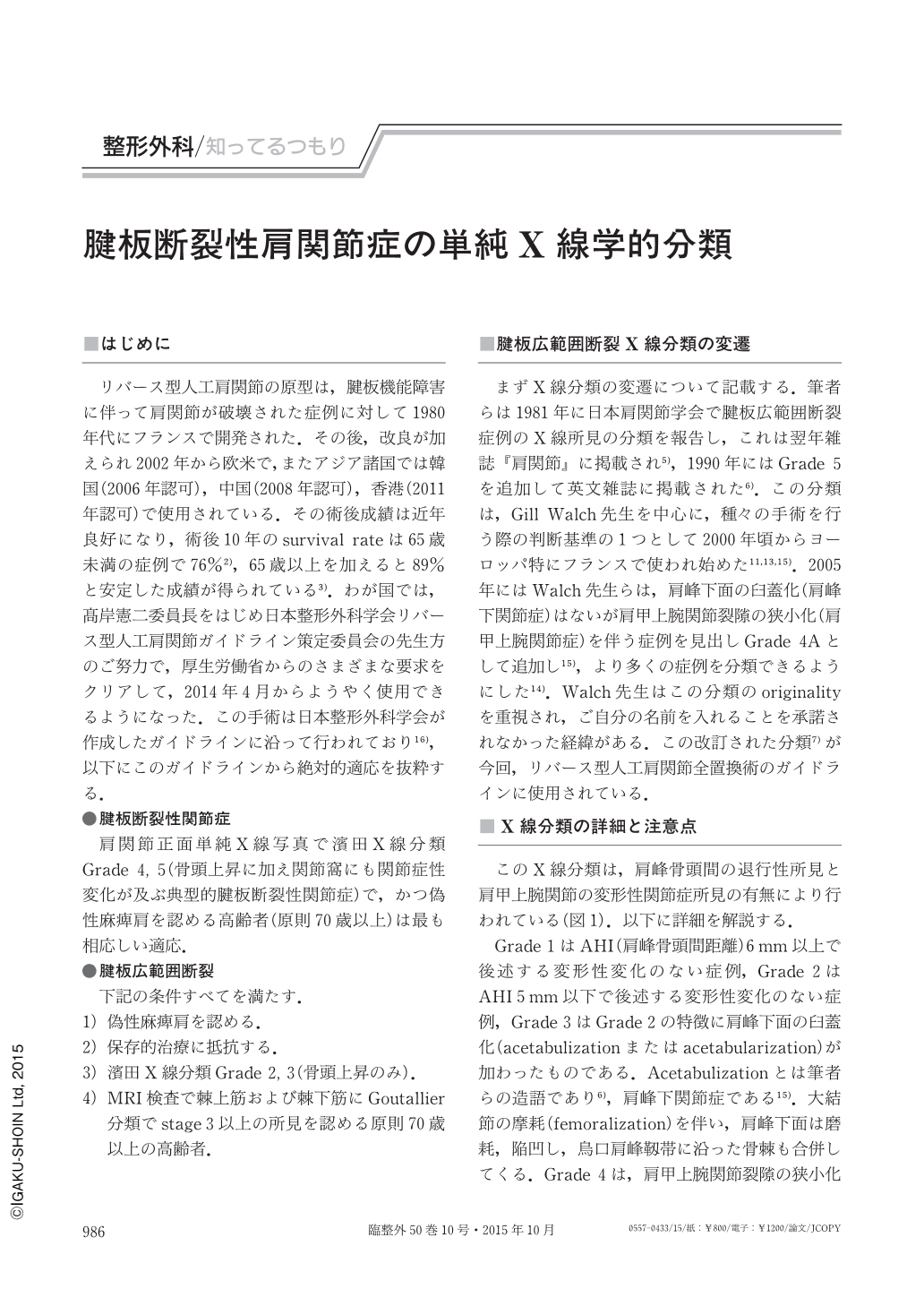8 0 0 0 OA 肩石灰性腱炎に対するH2受容体拮抗薬の治療効果
- 著者
- 繁田 明義 内山 善康 橋本 紘行 持田 讓治 新福 栄治 大見 博子
- 出版者
- 日本肩関節学会
- 雑誌
- 肩関節 (ISSN:09104461)
- 巻号頁・発行日
- vol.35, no.3, pp.907-910, 2011 (Released:2011-12-21)
- 参考文献数
- 16
- 被引用文献数
- 3
Many studies have reported treatment effects of H2 receptor antagonists (H2RA) on calcific tendinitis (CT) of the shoulder. The purpose of this retrospective study is to compare the clinical outcome between the cimetidine and the famotidine of CT of the shoulder. We studied 72 patients with CT of the shoulder who were closed with H2RA (cimetidine or famotidine) and loxoprofen sodium from 2005. They were treated as follows, 41 with cimetidine and loxoprofen (group C) (14 males, 27 females, average age 54.3 years old) 17 with famotidine and loxoprofen (group F) (10 males, 7 females, average age 58.4 years old) and 14 with loxoprofen(group N) (8 males, 6 females, average age 60.2 years old). Shoulder joint pain was assessed by using visual analogue scale (VAS), and the site and size of calcium deposits were calculated by X-rays (frontal view and scapula Y). In addition, influences of the complicating diseases (diabetes mellitus and hypertension) were evaluated for treatment effects. Groups C and F improved their pain and decreased calcium deposit size more than group N (p<0.05). However, the pain and calcium deposit size was not significantly different between group C and group F. Diabetic patients reduced the effectiveness more than non-diabetic patients in groups C and F. Hypertensive patients reduced the reduction ratio of calcium deposit more than non- hypertensive patients in groups C and F. There were the same clinical results for both cimetidine and famotidine for the CT of the shoulder. Diabetes mellitus and hypertension inhibited the treatment effects of H2RA.
- 著者
- 柏木 圭介 野田 健登 孫田 岳史 松本 仁美 東福寺 規義 南谷 晶 海老沢 恵 正門 由久 内山 善康
- 出版者
- JAPANESE PHYSICAL THERAPY ASSOCIATION
- 雑誌
- 日本理学療法学術大会
- 巻号頁・発行日
- vol.2012, pp.48100529-48100529, 2013
【はじめに、目的】 肩腱板断裂術後患者において,日常生活動作の獲得は重要な要素である.日常生活動作の獲得は様々な運動機能や環境要素が組み合わさることで可能となるものであり,医療従事者側からの客観的評価(JOA score,Constant score 等)のみではなく患者側による評価も重要な要素である.この患者側による評価を用いた研究は術後6ヶ月,1年,2年と経過の長い対象の報告が多いが,詳細な経時的なデータはなく,術後6ヶ月以内の比較的早期の報告はない.今回我々は2011年に日本肩関節学会より作成された患者立脚型評価システムShouder36 V.1.3(以下,S36)を使用し,当院で行った肩腱板断裂術後患者を対象に経時的評価を行ったので報告する.【方法】 対象は関節鏡を利用したmini-open法で手術を行い,当院の肩腱板断裂術後プロトコールで理学療法を施行した中断裂以下の肩腱板断裂患者12名12肩(男性:9名,女性:3名)とした.手術時年齢は平均57.3±13.0歳であり,術後3,4,5ヶ月時点にS36の用紙による自己記述式アンケート調査を実施し,各領域において各月の点数を比較検討した.なお,S36は全6領域36項目であり,各項目の順番をランダム化し,疼痛(6項目),可動域(9項目),筋力(6項目),日常生活動作(7項目),健康感(6項目),スポーツ能力(2項目)について回答する.点数は5段階(0-4)で値が大きいほど良好な状態を示し,各領域間の平均値を算出するものである.統計処理はTukeyのHSD検定を用い,有意水準5%未満を有意差有りとした.【倫理的配慮、説明と同意】 本研究は,東海大学医学部付属病院臨床研究審査委員会(受付番号11R085号)により承認された.尚,対象者には研究目的および研究方法を十分に説明し同意を得た.【結果】 S36の各項目の得点は,術後3ヶ月,4ヶ月,5ヶ月の順に,可動域は3.3点,3.7点,3.8点であり,3ヶ月と5ヶ月間に有意な改善を認めた(p=0.017).疼痛は3.2点,3.7点,3.8点であり,3ヶ月と5ヶ月間に有意な改善を認めた(p=0.016).筋力は2.9点,3.3点,3.5点,日常生活動作は3.3点,3.8点,3.8点,健康感は3.3点,3.8点,3.8点,スポーツ能力は2.3点,2.6点,2.9点であり,筋力,日常生活動作,健康感,スポーツ能力においては有意差を認めなかった.【考察】 S36において,術後3ヶ月と5ヶ月間で可動域と疼痛の改善に有意差がみられた。これは可動域と疼痛の項目は肩関節下垂位や挙上90°以下の動作が多く,比較的難易度が低い運動であるため,術後に改善が得られたと考える.しかし,筋力の項目は挙上90°以上での保持動作が多いため,3ヶ月から5ヶ月の短期間では改善が乏しく,差が出なかったと考えられた.次に有意差を認めた領域の項目を検討すると,可動域において術後3ヶ月と5ヶ月間で最も得点の変化が少なかったのが「反対側のわきの下を洗う」であり,次いで「エプロンのひもを後ろで結ぶ」であった.これは,今後の内転,内旋動作獲得の重要性が示唆された.また,疼痛の項目において術後5ヶ月で最低得点であった「後ろポケットに手を伸ばす」は患側の肩関節伸展,内旋動作により棘上筋への伸張ストレスによる疼痛が考えられ,改善が乏しかった.このことより,当院の肩腱板断裂術後プロトコールでは伸展と内旋のストレッチを6週まで制限しており,その他の運動と比較すると運動許可時期が遅いため,その後の改善に時間を要すと考えた.以上より,疼痛と肩関節内旋可動域制限との比較の必要性が示唆された.さらに,術後3ヶ月で最低得点であった「患側を下にして寝る」は術後5ヶ月で改善がみられた.それは圧迫ストレスの疼痛であり,術後の炎症や術前の疼痛が関連し,術後経過と共に疼痛が軽減したものと考えられる.日常生活動作と健康感は術後3ヶ月時点ですでに高得点であり,その後の改善に有意差を認めなかった.スポーツ能力は術後3ヶ月から5ヶ月において低い得点のままであり,対象の年齢では項目の難易度が高いことが考えられた.【理学療法学研究としての意義】 患者立脚型評価としてのS36を用いて,中断裂以下の肩腱板断裂術後患者における各領域の3ヶ月から5ヶ月の経過を追い,術後3ヶ月から5ヶ月で可動域と疼痛の項目の改善を認めた.今後はS36と医師(整形外科医,リハビリ科医),理学療法士からの客観的評価を比較検討していきたい.
1 0 0 0 腱板断裂性肩関節症の単純X線学的分類
はじめに リバース型人工肩関節の原型は,腱板機能障害に伴って肩関節が破壊された症例に対して1980年代にフランスで開発された.その後,改良が加えられ2002年から欧米で,またアジア諸国では韓国(2006年認可),中国(2008年認可),香港(2011年認可)で使用されている.その術後成績は近年良好になり,術後10年のsurvival rateは65歳未満の症例で76%2),65歳以上を加えると89%と安定した成績が得られている3).わが国では,髙岸憲二委員長をはじめ日本整形外科学会リバース型人工肩関節ガイドライン策定委員会の先生方のご努力で,厚生労働省からのさまざまな要求をクリアして,2014年4月からようやく使用できるようになった.この手術は日本整形外科学会が作成したガイドラインに沿って行われており16),以下にこのガイドラインから絶対的適応を抜粋する.
1 0 0 0 柔道選手における肩鎖関節脱臼放置例の検討
- 著者
- 宮崎 誠司 浜田 一寿 中島 知隆 内山 善康 福田 宏明
- 出版者
- Japan Shoulder Society
- 雑誌
- 肩関節 = Shoulder joint (ISSN:09104461)
- 巻号頁・発行日
- vol.22, no.3, pp.371-374, 1998-09-30
- 参考文献数
- 9
- 被引用文献数
- 1
In order to evaluate the residual disabilities caused by chronic acromioclavicular (A-C) dislocations,14 Judo athletes (7 cases of Grade II and 7 cases of Grade III) injuries were reviewed. Clinical examinations and isokinetic muscle strength of internal/external rotation and of flexion/extension in the supine position were examined. In Grade II, there were no clinical symptoms or differences in isokinetic muscle strength between the involved and uninvolved sides.<BR>In Grade III,4 cases had motion pain and 3 cases felt weakness in Judo practice. In Grade III the A-C joints, the directions of instability were horizontal as well as vertical. Work magnitudes of extension (60 deg/sec) and those of external rotation at 30° abduction (60 and 120 deg/sec)were less in the involved side than those in the uninvolved sides. Isokinetic muscle strength of extension and external rotation at 30° abduction (60 deg/sec) in Grade III was smaller than that in Grade II. Characteristically, the involved side of Grade III cases had less power than the uninvolved side in flexion/extension above the horizontal level. In Grade III, the torn A-C capsular and coracoclavicular ligaments produce more unstable A-C joints than in Grade II.<BR>During an arm elevation above the horizontal level, more than 3/4 of a clavicle rotation occurs and is controlled by the trapezoid ligament. Unstable A-C joint causes an unstable scapula, leading to muscle weakness of the shoulder, especially in flexion/extension above the horizontal level. The current study showed that the Grade III had patterns in the flexion/extension which were different in the involved and uninvolved sides.<BR>This could explain why there is weakness above the horizontal level in Grade III injuries. Therefore, an operation is recommended for Grade III A-C injuries of Judo athletes.
- 著者
- 内山 善康 浜田 一寿 中島 知隆 福田 宏明 宮崎 誠司
- 出版者
- Japan Shoulder Society
- 雑誌
- 肩関節 = Shoulder joint (ISSN:09104461)
- 巻号頁・発行日
- vol.22, no.3, pp.537-541, 1998-09-30
- 参考文献数
- 10
- 被引用文献数
- 6
The purpose of this study was to compare the limitations between the external rotation (ER) of athletes in overhand sports players (OS) and judo players (JP) with traumatic anterior shoulder instability after a modified inferior capsular shift (MICS)procedure. Thiryt-two shoulders of OS and 38 shoulders of JP were operated on using MICS and were observed for more than 12 months postoperatively.<BR>Twenty-six dominant and 6 nondominant shoulders were examined directly. There were 21 “tsurite” (lapel grip) and 17 “hikite” (sleeve grip) shoulders in JP. The average ages at surgery of OS and JP were 22.9 and 21.5 years old, respectively.<BR>All the patients had had an episoders of sports injury. There were no recurrences in OS, but 3 (8%)in JP. In OS,12% of the dominant shoulders and 67% of the no ndominant sides after MICS could perform better their sports activities than preoperatively. The ratios of JP which showed a better performance were 15% of operated “tsurite” and 52% of the operated “hikite” sides. The average decrease of ER motion in dominant shoulders of OS was 18.8°in the hanging position and 14.5°in 90°of abduction. In JP, “tsurite” sides had 3.3°and 4.8°of limitation on 0°and 90°of abduction, respectively. There was on other limitation of ROM in either OS or JP, postoperatively. Based on comparisons of ER motion between OS and JP showing better sport activity, ER at 90°abduction should be 80°for the dominant side of OS and 85°for the “tsurite” side of JP in order to get a better performance, postoperatively. Thus, the “tsurite” side in JP should be treated in the same manner as that of the dominant side of OS.
